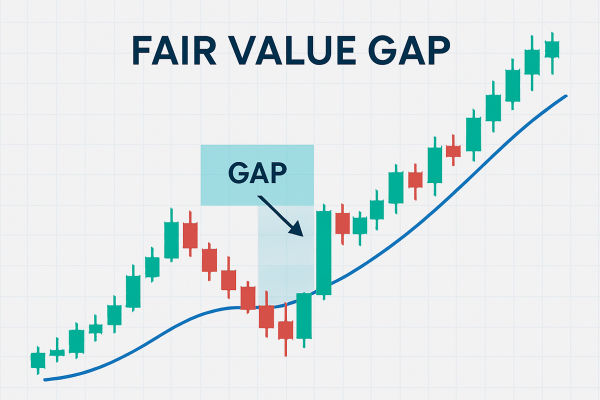Swing trading bridges the gap between the fast-paced world of day trading and the patience required for long-term investing. By holding positions for a few days to several weeks, this trading style allows market participants to capture meaningful price movements during short- to medium-term trends. Whether you're a seasoned trader or just starting, swing trading offers a practical approach to seizing market opportunities.

Defining Swing Trading
At its core, swing trading focuses on leveraging price "swings" within a market trend. Unlike day trading, which involves closing positions within the same day, swing trading enables traders to hold assets over extended periods to ride out larger price shifts. This approach relies heavily on technical analysis to pinpoint ideal entry and exit points while aligning trades with prevailing market momentum.
Swing trading works across different market conditions, whether the market is trending or range-bound. By using tools like Chart Patterns and technical indicators, traders can identify lucrative opportunities without needing to monitor markets around the clock.
Who Are Swing Traders?
Swing traders are adaptive market participants who aim to capitalize on significant price moves within days or weeks. Unlike investors, they don't seek to hold positions for long periods. Instead, they focus on capturing chunks of a trend before moving on to the next opportunity.
Typically, swing traders excel at chart analysis, pattern recognition, and quick decision-making. They combine technical tools with occasional fundamental insights to filter potential trades. Patience and discipline are key traits, as success often hinges on timing and strategy execution.
Core swing trading strategies
Swing trading offers various strategies tailored to market conditions, with the exit point being a crucial aspect of managing trades. Some of the most popular include:
Trend-Following Strategy: This approach involves identifying the overall direction of the market and trading in line with that trend. Traders often use indicators like moving averages to confirm the trend and enter trades during pullbacks in uptrends or temporary rallies in downtrends.
Breakout Strategy: Breakout trading focuses on entering a trade when the price surpasses a defined support or resistance level. This signals the beginning of a new trend. Traders rely on high trading volumes and patterns like triangles or wedges to confirm the breakout's validity.
Reversal Strategy: Reversal trading is about predicting market turning points. Traders use indicators like the Relative Strength Index (RSI) or Moving Average Convergence Divergence (MACD) to identify overbought or oversold conditions. These signals suggest when a trend is likely to reverse, offering a prime opportunity for entry.
Range Trading: In range-bound markets, traders look to capitalize on predictable price oscillations between support and resistance levels. Tools like the Stochastic Oscillator help confirm when the price is nearing these critical levels, allowing traders to time their trades effectively.
Technical Analysis: The Swing Trader's Toolbox
Technical analysis plays a pivotal role in swing trading. Indicators such as moving averages, Bollinger Bands, and Fibonacci retracements guide traders in identifying trends and potential reversal points. Additionally, candlestick patterns like engulfing candles or hammers can reveal market sentiment and potential turning points.
While swing traders primarily rely on technical analysis to determine trade opportunities, they also incorporate fundamental analysis as an essential part of their strategy. This dual approach helps traders validate bullish setups by ensuring that the underlying fundamentals of a stock are favorable.
By combining these tools with a thorough analysis of support and resistance levels, swing traders develop a roadmap for entering and exiting trades.
Choosing the Right Securities for Swing Trading
When it comes to swing trading, choosing the right securities is crucial for success. Swing traders typically focus on liquid and volatile stocks, as they offer the best opportunities for short-term price movements. Here are some factors to consider when selecting securities for swing trading:
Liquidity: Look for stocks with high trading volumes and tight bid-ask spreads. Liquid stocks ensure you can enter and exit positions without significant price slippage, making your trades more efficient.
Volatility: Choose stocks with a history of price movements, as they offer more opportunities for swing trades. Volatile stocks are more likely to experience the price swings that swing traders rely on to generate profits.
Market Capitalization: Large-cap stocks tend to be more liquid and less volatile, making them suitable for swing trading. However, don’t overlook mid-cap and small-cap stocks, which can offer higher volatility and potentially larger price swings.
Industry Trends: Focus on industries with strong trends and momentum, as they can provide a tailwind for your swing trades. For example, if the tech sector is booming, tech stocks might offer more lucrative swing trading opportunities.
Technical Analysis: Use technical indicators and chart patterns to identify potential swing trading opportunities. Tools like moving averages, Bollinger Bands, and Fibonacci retracements can help you pinpoint ideal entry and exit points.
By considering these factors, you can select securities that align with your swing trading strategies and increase your chances of success.

Finding Stocks to Swing Trade
Finding the right stocks to swing trade can be a challenging task, but there are several strategies you can use to identify potential opportunities. Here are some tips to help you find stocks to swing trade:
Use Stock Screeners: Utilize stock screeners to filter stocks based on your criteria, such as liquidity, volatility, and market capitalization. Stock screeners can save you time and help you quickly identify stocks that meet your swing trading criteria.
Follow Industry Trends: Keep an eye on industry trends and news, as they can provide insights into potential swing trading opportunities. For instance, if a particular industry is experiencing strong growth, stocks within that industry may present good swing trading prospects.
Analyse Charts: Use technical analysis to identify chart patterns and trends that can indicate potential swing trading opportunities. Look for patterns like head and shoulders, double tops, and triangles, which can signal upcoming price movements.
Monitor News and Events: Keep an eye on news and events that can impact Stock Prices, such as earnings announcements and economic data releases. These events can create volatility and provide opportunities for swing trades.
Use Swing Trading Software: Consider using swing trading software that can help you identify potential swing trading opportunities and provide trade alerts. These tools can analyse market data and alert you to potential trades based on your criteria.
By employing these strategies, you can find stocks that are well-suited for swing trading and increase your chances of making profitable trades.
Why Swing Trading Stands Out
Swing trading strikes a balance between the rapid decisions of day trading and the long-term patience of investing. Its flexibility makes it appealing to those juggling trading with other responsibilities. Traders benefit from the ability to participate in meaningful market moves without the stress of daily market monitoring.
Compared to other investment strategies like day trading and long-term buy and hold, swing trading allows traders to capitalize on price fluctuations over multiple days, offering a unique approach to market participation.
Moreover, swing trading offers clear advantages in terms of potential returns. By holding positions longer than a single day, traders can capture broader price movements. With proper planning and strategy, the rewards often outweigh the risks.
Comparing Swing Trading and Day Trading
Unlike day trading, which involves dozens of trades daily and requires constant monitoring, swing trading involves holding positions for a duration that typically exceeds one trading session, often extending for several days to weeks. This relaxed pace makes it more accessible to those unable to dedicate entire days to trading.
Swing trading also differs in its focus. While day trading prioritizes small intraday price movements, swing trading aims to profit from larger trends, resulting in fewer trades but potentially higher returns.
By adhering to these practices, traders can mitigate risks while maximizing opportunities.
Common Mistake to Avoid
Swing trading can be a profitable strategy, but it's not without its risks. Here are some common pitfalls to avoid when swing trading:
Overtrading: Avoid overtrading, as it can lead to significant losses and decreased performance. Stick to your Trading plan and only take trades that meet your criteria.
Lack of Risk Management: Failing to manage risk can result in significant losses, so make sure to set stop-losses and limit your position size. Proper risk management is crucial to long-term success in swing trading.
Emotional Trading: Avoid making emotional decisions, as they can lead to impulsive trades and decreased performance. Stick to your trading plan and rely on data-driven strategies to make informed decisions.
Lack of Patience: Swing trading requires patience, so avoid getting caught up in the excitement of the market and stick to your trading plan. Wait for the right opportunities and don't rush into trades.
-
Failure to Adapt: Markets are constantly changing, so make sure to adapt your trading strategy to changing market conditions. Stay informed about market trends and be willing to adjust your approach as needed.
By being aware of these common pitfalls and taking steps to avoid them, you can improve your swing trading performance and increase your chances of success.
Conclusion
Swing trading offers a practical approach for traders seeking to profit from short- to medium-term market trends. By mastering strategies like trend-following, breakouts, and reversals, and by implementing sound risk management, traders can position themselves for consistent success. This trading style is ideal for those who value flexibility and are ready to seize opportunities in ever-changing markets.
With preparation and a disciplined mindset, swing trading can be a highly rewarding endeavour for traders at any level.
Disclaimer: This material is for general information purposes only and is not intended as (and should not be considered to be) financial, investment, or other advice on which reliance should be placed. No opinion given in the material constitutes a recommendation by EBC or the author that any particular investment, security, transaction, or investment strategy is suitable for any specific person.








